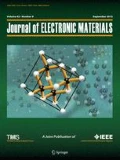Abstract
The (111)B-oriented Cd0.96Zn0.04Te substrates with rough surfaces have been found to have infrared (IR) transmission spectra which decrease rapidly in intensity as the photon energy increases. The rough surfaces were produced by Everson etching or rough polishing. The descending spectra could be qualitatively described by an equation found in the literature. Flat low intensity IR transmission spectra were found to be due to a combination of free carrier absorption and rough surfaces. The B-side of the substrate is the growth side. By etching the A-side of the substrate only we found that the black layer formed by the Everson etch on this side introduces two features in the IR transmission spectra: a dip at approx. 625 cm−1 and a special kind of ascending IR transmission spectrum: The ascending spectrum increases from approx. 65% at 500 cm−1 up to 72.5% at the highest wavenumbers around 4000 cm−1. There is a correlation between the dip and the ascending spectrum: six out of the seven spectra with largest dip have the highest transmission at 4000 cm−1 suggesting a common origin.
Similar content being viewed by others
References
S. Sen, D.R. Rhiger, C.R. Curtis, M.H. Kalisher, H.L. Hettich, and M.C. Currie, J. Electron. Mater. 30, 611 (2001).
R.D.S. Yadava, B.S. Sundersheshu, M. Anandan, R.K. Bagai, and W.N. Borle, J. Electron. Mater. 23, 1349 (1994).
G. Li and W. Jie, Mater. Sci. Forum 475, 1841 (2005).
L. Yujie, G. Zhi, L. Guoqiang, and J. Wanqi, J. Electron. Mater. 33, 861 (2004).
H. Bensalah, J. Crocco, V. Carcelén, A. Black, Q. Zheng, J.L. Plaza, and E. Diéguez, J. Cryst. Growth 361, 5 (2012).
I. Filinski, Phys. Status Solidi B 49, 577 (1972).
W.J. Everson, C.K. Ard, J.L. Sepich, B.E. Dean, G.T. Neugebauer, and H.F. Schaake, J. Electron. Mater. 24, 505 (1995).
Y. Xu, N. Jia, Y. He, R. Guo, Y. Gu, and W. Jie, CrystEngComm 17, 8639 (2015).
L. Burgess, F.J. Kumar, and J. MacKenzie, J. Electron. Mater. 44, 3277 (2015).
Acknowledgments
Laila Trosdahl-Iversen is acknowledged for Everson etching.
Author information
Authors and Affiliations
Corresponding author
Additional information
Publisher's Note
Springer Nature remains neutral with regard to jurisdictional claims in published maps and institutional affiliations.
Rights and permissions
About this article
Cite this article
Selvig, E., Kongshaug, K.O., Haakenaasen, R. et al. Descending Infrared Transmission Spectra of CdZnTe Substrates Due to Surface Roughness. J. Electron. Mater. 48, 6152–6158 (2019). https://doi.org/10.1007/s11664-019-07339-8
Received:
Accepted:
Published:
Issue Date:
DOI: https://doi.org/10.1007/s11664-019-07339-8


